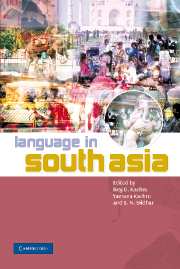Book contents
- Frontmatter
- Contents
- List of Figures
- List of Maps
- List of Tables
- Preface
- Acknowledgments
- List of Abbreviations
- Note on Transcription
- Introduction: languages, contexts, and constructs
- Part 1 Language history, families, and typology
- Part 2 Languages and their functions
- Part 3 Sanskrit and traditions of language study
- Part 4 Multilingualism, contact, and convergence
- 10 Contexts of multilingualism
- 11 Language contact and convergence in South Asia
- 12 Pidgins, Creoles, and Bazaar Hindi
- Part 5 Orality, literacy, and writing systems
- Part 6 Language conflicts
- Part 7 Language and modernization
- Part 8 Language and discourse
- Part 9 Language and identity
- Part 10 Languages in diaspora
- References
- Subject Index
- Language Index
- Author Index
11 - Language contact and convergence in South Asia
Published online by Cambridge University Press: 04 May 2010
- Frontmatter
- Contents
- List of Figures
- List of Maps
- List of Tables
- Preface
- Acknowledgments
- List of Abbreviations
- Note on Transcription
- Introduction: languages, contexts, and constructs
- Part 1 Language history, families, and typology
- Part 2 Languages and their functions
- Part 3 Sanskrit and traditions of language study
- Part 4 Multilingualism, contact, and convergence
- 10 Contexts of multilingualism
- 11 Language contact and convergence in South Asia
- 12 Pidgins, Creoles, and Bazaar Hindi
- Part 5 Orality, literacy, and writing systems
- Part 6 Language conflicts
- Part 7 Language and modernization
- Part 8 Language and discourse
- Part 9 Language and identity
- Part 10 Languages in diaspora
- References
- Subject Index
- Language Index
- Author Index
Summary
Introduction
It is often remarked that South Asia has a genius for assimilating foreign influences without losing its essential character. Nowhere is this resilience demonstrated more clearly than in the way the Dravidian languages have absorbed what, by any count, must be regarded as massive Indo-Aryan influence and yet retained their essential Dravidian character.
In discussing the Indo-Aryanization of Dravidian languages, we are talking about an ongoing phenomenon that must have started more than about 3,500 years ago. The presence of linguistic features of possibly Dravidian origin in the Rig Veda (e.g. retroflex consonants) suggests Aryan contact with the Dravidian-speaking peoples as several hundred years before the composition of the Rig Veda (at least 1500 bce). This possibility is confirmed by the geographical distribution of the Dravidian languages, for example Brahui in Balochistan (Pakistan); Gondi in Madhya Pradesh, Maharashtra, Orissa, and Andhra Pradesh; Malto in Bihar and West Bengal, among others. Ignoring the possibility of reverse migration, this scatter suggests the presence of Dravidian-speaking people over most of South Asia at one time and their gradual recession before the advancing Aryans or language shift to Indo-Aryan over many generations (see Chapter 1). However, our recorded history of Dravidian contact with Indo-Aryan goes back only to the early centuries bce.
Language contact and convergence in South Asia may be – and has been – studied from many points of view.
- Type
- Chapter
- Information
- Language in South Asia , pp. 235 - 252Publisher: Cambridge University PressPrint publication year: 2008
- 5
- Cited by



